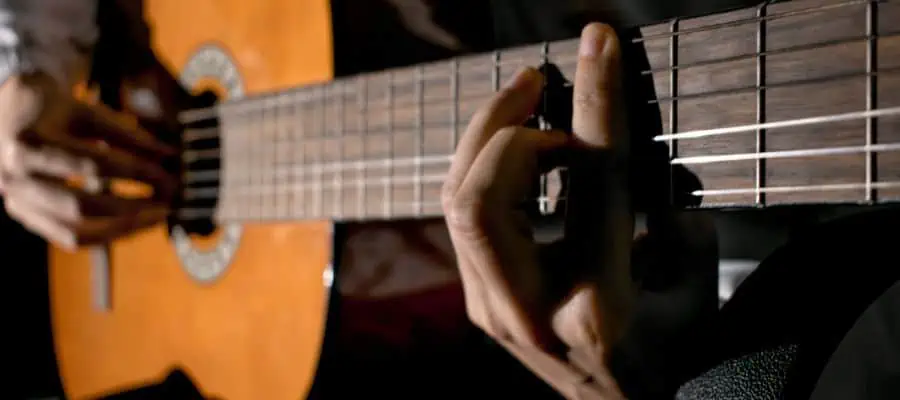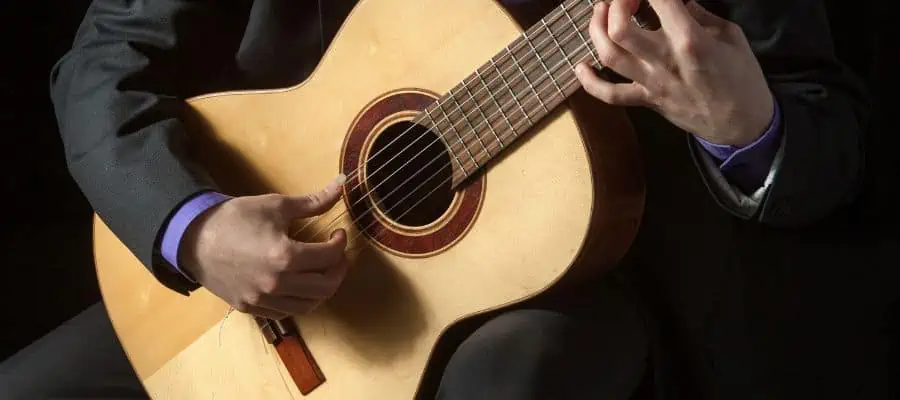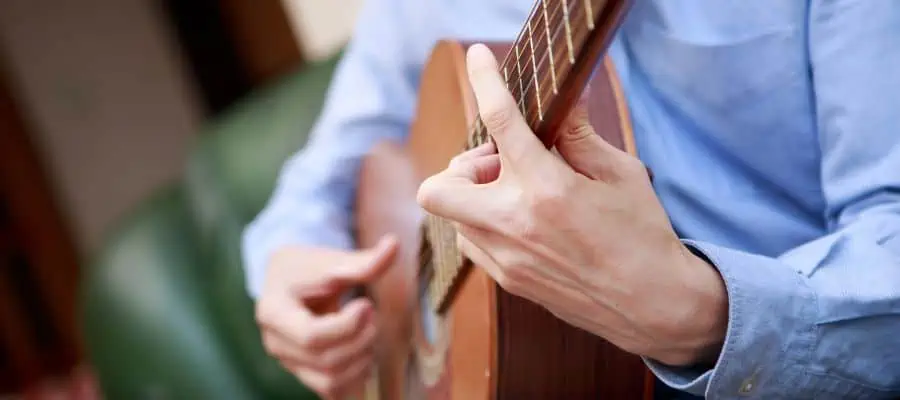If you’ve played guitar long enough to experiment with several varieties, you know how different their sound and technique can be. However, something that surprises a lot of musicians when switching from acoustic to classical is that the latter needs to be held very differently. But why is that?
Classical guitars are held differently because they require a specific technique to produce their signature sound. Its positioning involves sitting with the guitar rested on your left leg, the neck of the guitar angled upwards, the headstock around your eye level, and its body held at a slight angle away from your body.
This unique positioning doesn’t only affect the sound that the instrument produces but also your comfort level while playing it. So, if you’re interested in learning more about the benefits of holding a classical guitar this way, how to properly hold such an instrument, and how positioning generally affects the performance of a guitar, make sure to read on.
Benefits of Holding a Classical Guitar Differently

Holding a classical guitar upright and at a slight angle comes with several benefits, so let’s explore some of them below:
- Improved sound quality. This technique allows for more natural resonance and soundboard vibration, resulting in a more balanced sound.
- Reduced tension and strain. Holding your guitar in an upright position reduces tension on your back, neck, and shoulders. It also encourages greater finger dexterity.
- Better access to the first position. This way of holding the guitar allows you to nail that first position without having to cramp your wrist too much.
- Ergonomic advantage. Since classical guitar playing revolves around strumming rather than intricate left-hand work, this position is more practical for the picking hand.
- Aesthetic value. Holding your guitar in an elegant, upright position is much more aesthetically pleasing than pressing it against your torso the regular way. That’s why many public performers especially enjoy these types of instruments.
- Traditional approach. Classical guitar is a highly honored instrument across many cultures, and playing it the way it was traditionally meant to show respect for its long-standing history.
How To Hold a Classical Guitar

Now that you’re better informed on all the advantages of the unique positioning of classical guitars, it’s time to explore how to hold one of these instruments in the first place properly.
Here’s how to hold a classical guitar:
- Sit on a chair without armrests and place the guitar on your left leg.
- Have the waist of your guitar rest on your left thigh and its bottom on your right one.
- Position the guitar’s neck upward at a 45-degree angle.
- Use your forearm to hold the guitar against your body.
- Position your left-hand fingers on the guitar’s neck, supporting it with your thumb.
- Position your right hand over the soundhole, resting the pinky on the guitar’s face to provide additional support.
- Sit up straight (posture is essential in classical guitar playing!), ensuring both feet are touching the floor.
- Start playing!
Though the whole process might feel unnatural at first, especially if you’re used to playing exclusively acoustic or electric guitars, if you keep at it and practice, it’ll all start feeling much easier over time.
The goal of this position is to encourage unrestricted movement. Don’t forget that a lot of pressure will be taken off your back, neck, and shoulders, so you’ll be much better able to play for extended periods without feeling fatigued.
That’s why it’s worth practicing until properly holding a classical guitar becomes second nature. Though most guitarists are used to playing their instruments horizontally, no habit is too stubborn to overcome with practice, given enough time.
Before moving on to the next section, I want to reiterate the importance of your posture when properly holding a classical guitar. This position won’t feel comfortable at first, so it’s easy to crouch or lean back for some much-needed relief; however, that’ll do more harm than good in the long run.
If you can’t seem to perfect your posture immediately, I highly recommend using a footstool to force your body into a better, more comfortable position. With a footstool, you can have the elevation on your left leg, to which you are positioning your guitar, to make the guitar position more comfortable. This way, you can eliminate the need to twist or cross a leg over the other.
Tips for Holding a Classical Guitar Properly

- Get a proper seat. Your seat should allow your feet to be equally on the floor, with the top of your legs staying parallel to the floor or slightly tilted down.
- Sit on the edge. Try to sit on the tip of the chair and prevent yourself from leaning back. It may be uncomfortable initially, but you will grow in strength.
- Balance your sit bones. By rocking side to side and front to back, find the sweet spot to balance your weight on your sit bones for a more comfortable position.
- Keep the guitar neck up. Try to keep the guitar neck up to make things easier for your hands. The headstock should be at least at your eye level or even higher. This will also force you to maintain an upright position without slumping.
- Take breaks. Remember to take breaks to check your posture and rest your back muscles in your first attempts with the correct posture. Playing in front of a mirror is also a good idea.
- Play frequently, and be bold and explore. The best way to get used to classical guitar positions is to play as much as possible and explore your strengths and weaknesses. So, as always, practice makes perfect!
How Positioning Affects the Performance of a Guitar

If you’ve made it thus far, you might wonder: “How come something as simple as the positioning of your guitar can affect its performance so much?”. You might be surprised to learn that that’s a constant across all instruments of this genre and that the classical variety is no exception.
However, how does positioning affect the performance of a guitar? Here’s how:
- Tone. The way a guitar is held affects, first and foremost, its tone. Since the sound these instruments produce originates from, you guessed it, the soundboard will also change its projection and resonance when tilted at specific angles. These qualities are ideal at that perfect angle, resulting in the perfect tone.
- Technique. The positioning of a guitar also affects your ability to achieve specific techniques. Moreover, it can help reduce slow transitions, muscle tension, and fatigue.
- Comfort. Since I’ve mentioned several times throughout this article that classical guitar positioning helps alleviate neck, back, and shoulder strain, you already know that the way you hold a guitar can significantly affect your comfort level, which can make or break your entire performance.
- Artistic expression. One of the first things anyone notices about a musician is how they interact with their instrument – how they hold it and move along to complement their sound. That’s why the positioning of a guitar can also serve as a means of artistic expression.
Conclusion
Proper positioning is essential for any guitarist’s tone, technique, and comfort level; however, it’s even more critical for classic guitar players looking to get the best sound and overall performance out of their instrument.
Classical guitars are held upright and at a 45-degree angle because this positioning helps optimize their sound quality and aesthetic value. It also reduces physical strain, making it easier for the player to perform for extended periods. Last but not least, this positioning holds cultural value, and perfecting it allows you to showcase your respect for its long-standing tradition.
If you found this article useful, you may want to save this pin below to your Guitar board.

Recent Posts
Some guitarists insist on buying an expensive amplifier with their electric guitar. They assume that this is a must for every type of guitarist out there. However, in some situations, this isn’t...
Top 50 Free Realistic Guitar VST Plugins With Sound Examples
As technology has rapidly advanced in the recent decade, computers are stealing more and more roles from physical musical instruments and accessories. Nowadays, you do not need expensive amps,...

